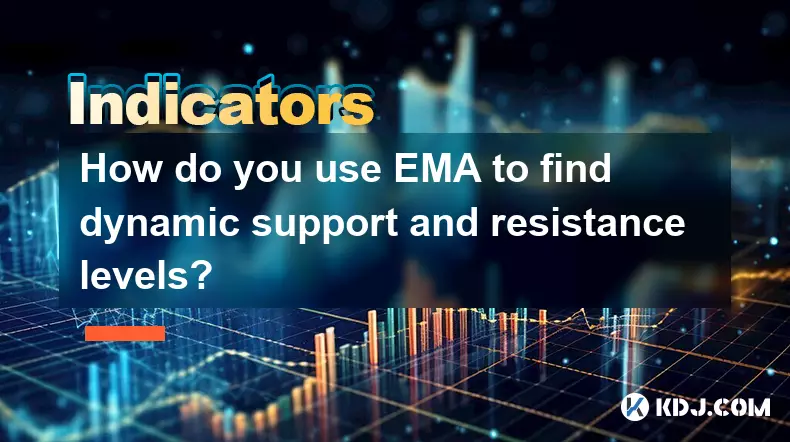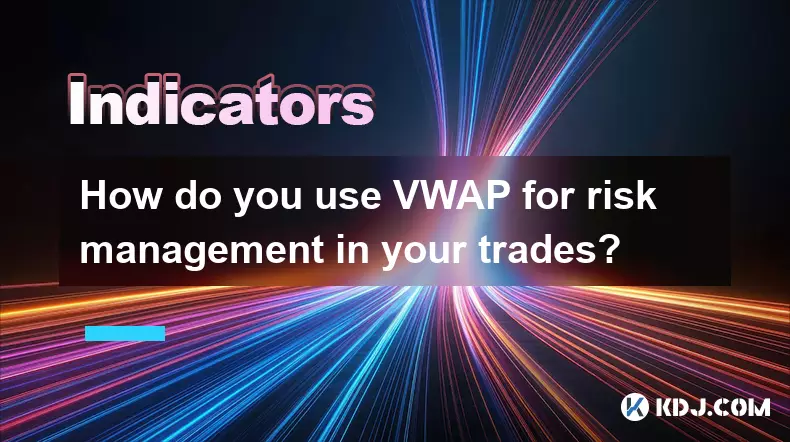-
 bitcoin
bitcoin $114684.631706 USD
-0.87% -
 ethereum
ethereum $4228.677447 USD
1.58% -
 bnb
bnb $1294.880693 USD
-1.16% -
 tether
tether $1.000819 USD
-0.02% -
 xrp
xrp $2.605138 USD
2.79% -
 solana
solana $209.908690 USD
5.89% -
 usd-coin
usd-coin $0.999903 USD
-0.03% -
 dogecoin
dogecoin $0.213423 USD
2.93% -
 tron
tron $0.322721 USD
-0.10% -
 cardano
cardano $0.727247 USD
3.66% -
 hyperliquid
hyperliquid $42.339456 USD
6.05% -
 chainlink
chainlink $19.910811 USD
5.16% -
 ethena-usde
ethena-usde $1.000557 USD
0.00% -
 stellar
stellar $0.349734 USD
2.69% -
 bitcoin-cash
bitcoin-cash $543.848687 USD
-0.21%
How do you use EMA to find dynamic support and resistance levels?
The EMA is a dynamic tool in crypto trading, offering responsive support/resistance levels that adapt to price action, with key periods like 21 and 50 widely used for spotting trends and reversals.
Oct 11, 2025 at 12:54 am

Understanding EMA in Cryptocurrency Trading
1. The Exponential Moving Average (EMA) is a widely used technical indicator in the cryptocurrency market due to its responsiveness to recent price changes. Unlike the Simple Moving Average (SMA), which treats all data points equally, EMA assigns greater weight to recent prices, making it more sensitive to short-term fluctuations.
2. Traders use EMA to identify trends and potential reversal zones by observing how price interacts with specific EMA lines on the chart. When price consistently respects an EMA level as a floor during uptrends or a ceiling during downtrends, that EMA begins to function as dynamic support or resistance.
3. Common EMA periods such as 9, 21, 50, and 200 are frequently monitored across various timeframes. Shorter EMAs like the 9-period react quickly and often act as immediate support or resistance in fast-moving crypto markets, while longer EMAs like the 200-period provide broader trend context.
4. In strong bullish trends, price tends to hover above key EMAs, using them as support during pullbacks. A bounce off the 21-day EMA on a daily chart may signal renewed buying interest. Conversely, in bearish conditions, price often finds resistance when approaching the same EMA from below.
5. Dynamic levels shift with each new candle, adapting to evolving market sentiment, unlike static horizontal support/resistance zones. This makes EMA particularly useful in volatile environments where traditional levels can be invalidated rapidly.
Identifying Dynamic Support Using EMA
1. During an established uptrend, traders watch for price retracements toward major EMAs such as the 50 or 200-period. If price approaches these levels and shows signs of reversal—like bullish candlestick patterns or volume spikes—it suggests the EMA is acting as dynamic support.
2. Multiple touches of the same EMA without a breakdown increase confidence in its strength. For example, three successful bounces off the 21-EMA on the 4-hour chart reinforce its role as a reliable support zone.
3. Confluence enhances reliability. When an EMA aligns with a Fibonacci retracement level or a prior swing low, the probability of a successful bounce increases significantly.
4. Volume confirmation during a test of EMA support helps distinguish genuine reactions from false breaks. A decline in selling volume near the EMA followed by expanding buying volume supports the idea of accumulation.
5. Some traders combine EMA with oscillators like RSI to detect oversold conditions near dynamic support, adding another layer of validation before entering long positions.
Recognizing Dynamic Resistance with EMA
1. In downtrends, price often rallies toward key EMAs only to stall and reverse. The 9 or 21-period EMA on lower timeframes frequently serves as temporary resistance during counter-trend moves.
2. Failed breakouts above EMAs indicate persistent selling pressure. A wick extending above the 50-EMA but closing below it signals rejection, reinforcing the EMA’s role as resistance.
3. When price spends extended periods below a major EMA like the 200-day, that line becomes a psychological barrier for bulls. Repeated failures to reclaim it suggest ongoing bearish dominance.
4. Traders may use EMA resistance to time short entries or take profits on long positions. Placing stop-loss orders just above the EMA provides a logical risk point based on structure.
5. Compression near an EMA, where price oscillates tightly around the line, often precedes a directional breakout. Monitoring volatility contraction around these levels can offer early clues about impending momentum shifts.
Common Questions About EMA and Dynamic Levels
What EMA period is best for spotting dynamic support in Bitcoin?The 21-day and 50-day EMAs are commonly used on daily charts for Bitcoin. These periods balance responsiveness and reliability, often aligning with institutional trading cycles and macro-level sentiment shifts.
Can multiple EMAs act as support or resistance simultaneously?Yes. Clusters of EMAs—such as the 9, 21, and 50 converging in a narrow range—form stronger dynamic zones. These 'EMA stacks' often lead to pronounced reactions when tested, especially after trending phases.
How do you confirm a valid break of EMA support or resistance?A close beyond the EMA accompanied by increased volume and follow-through in the next few candles indicates a potential breakout. Single candle wicks or small intrabar breaches without confirmation are typically considered noise.
Does EMA work the same across all cryptocurrencies?While the mechanics remain consistent, effectiveness varies by liquidity and volatility. Major coins like Ethereum respond well to standard EMA settings, whereas low-cap altcoins may require adjustments due to erratic price action and manipulation risks.
Disclaimer:info@kdj.com
The information provided is not trading advice. kdj.com does not assume any responsibility for any investments made based on the information provided in this article. Cryptocurrencies are highly volatile and it is highly recommended that you invest with caution after thorough research!
If you believe that the content used on this website infringes your copyright, please contact us immediately (info@kdj.com) and we will delete it promptly.
- XRP Price Prediction: Weekend Rollercoaster or Rally?
- 2025-10-12 08:45:16
- Bittensor (TAO): Super Bullish Signals Point to Potential 2x Rally
- 2025-10-11 10:25:12
- Silver Price Correction: Navigating the Dip & Identifying Key SEO Keywords
- 2025-10-11 10:25:12
- Decoding Crypto Trends: Bittensor's Bull Run, Cardano's Dip, and LivLive's Presale Buzz in 'Uptober 2025'
- 2025-10-12 08:45:16
- MoonBull: The Crypto Meme Coin Promising 1000x Gains?
- 2025-10-11 10:30:01
- Crypto Payroll Revolution: Stablecoins, Altcoins, and the Future of Salary Payments
- 2025-10-11 10:30:01
Related knowledge

What's the main difference between VWAP and TWAP?
Oct 12,2025 at 11:54am
Understanding VWAP and Its Role in Crypto Trading1. Volume Weighted Average Price (VWAP) is a trading benchmark that calculates the average price of a...

How do you identify exhaustion moves using VWAP and its bands?
Oct 12,2025 at 08:00am
Understanding the Role of Decentralized Exchanges in Crypto Trading1. Decentralized exchanges (DEXs) operate without a central authority, allowing use...

How do you use VWAP to scale in and out of positions?
Oct 14,2025 at 02:19am
Understanding VWAP as a Dynamic Benchmark1. The Volume Weighted Average Price (VWAP) is not just an indicator—it functions as a dynamic benchmark that...

What are the main advantages of using VWAP over EMA?
Oct 11,2025 at 02:18am
Main Advantages of Using VWAP Over EMA1. Volume-Weighted Average Price (VWAP) incorporates trading volume into its calculation, offering a more accura...

How do you use VWAP on different chart types like Heikin Ashi?
Oct 11,2025 at 05:01pm
Understanding VWAP in the Context of Heikin Ashi Charts1. The Volume Weighted Average Price (VWAP) is a powerful analytical tool commonly used by trad...

How do you use VWAP for risk management in your trades?
Oct 11,2025 at 02:54am
Understanding VWAP as a Dynamic Benchmark1. The Volume Weighted Average Price (VWAP) serves as a crucial reference point in intraday trading by reflec...

What's the main difference between VWAP and TWAP?
Oct 12,2025 at 11:54am
Understanding VWAP and Its Role in Crypto Trading1. Volume Weighted Average Price (VWAP) is a trading benchmark that calculates the average price of a...

How do you identify exhaustion moves using VWAP and its bands?
Oct 12,2025 at 08:00am
Understanding the Role of Decentralized Exchanges in Crypto Trading1. Decentralized exchanges (DEXs) operate without a central authority, allowing use...

How do you use VWAP to scale in and out of positions?
Oct 14,2025 at 02:19am
Understanding VWAP as a Dynamic Benchmark1. The Volume Weighted Average Price (VWAP) is not just an indicator—it functions as a dynamic benchmark that...

What are the main advantages of using VWAP over EMA?
Oct 11,2025 at 02:18am
Main Advantages of Using VWAP Over EMA1. Volume-Weighted Average Price (VWAP) incorporates trading volume into its calculation, offering a more accura...

How do you use VWAP on different chart types like Heikin Ashi?
Oct 11,2025 at 05:01pm
Understanding VWAP in the Context of Heikin Ashi Charts1. The Volume Weighted Average Price (VWAP) is a powerful analytical tool commonly used by trad...

How do you use VWAP for risk management in your trades?
Oct 11,2025 at 02:54am
Understanding VWAP as a Dynamic Benchmark1. The Volume Weighted Average Price (VWAP) serves as a crucial reference point in intraday trading by reflec...
See all articles










































































